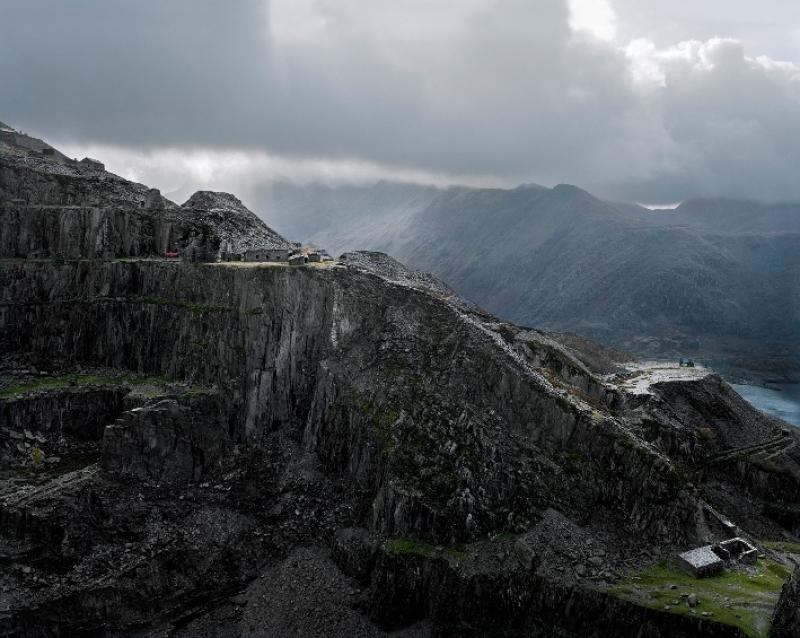Photo Gallery: A Landscape of Wales | reviews, news & interviews
Photo Gallery: A Landscape of Wales
Photo Gallery: A Landscape of Wales
Photographed: the scars left by industry on the face of Wales

The Welsh landscape promoted by the tourist board is a known entity. Postcard photographers patrol its contours waiting for the rains to desist and the sun to peer out so that they can snap splendid estuaries, meadowed shores patrolled by a lone diesel train, elegant county towns hibernating in the fold of a loafy hill, aqueducts and crumbling abbeys, beetling peaks and labyrinthine ravines.
The post-industrial Wales depicted here doesn’t always win admirers. Abandoned slate quarries, the scarred coalfield, caravan parks and terraced streets are all emblems of a Wales which saw the wealth, hewn out of the rock by its labourers, migrate elsewhere. And then there are the valleys dammed and flooded to keep the cities of Birmingham and Liverpool in hot bath water. And yet, while Morris's collection is of polemical landscapes, they have their own kind of frowning beauty.
[bg|/PHOTOGRAPHY/Jasper_Rees/Landscape_of_Wales]
- Craig Goch, Elan Valley, Powys
- Blaenau Ffestiniog, Gwynedd
- Ferndale, Rhondda Cynon Taf
- Ebbw Vale, Blaenau Gwent
- Blaengwynfi, West Glamorgan
- Neyland, Pembrokeshire
- Dragon Hotel, Swansea
- Sunnysands Caravan Park, Gwynedd
- A Landscape of Wales at the Aberystwyth Arts Centre until 5 June
- Find A Landscape of Wales (Dewi Lewis Publishing) on Amazon
Explore topics
Share this article
The future of Arts Journalism
You can stop theartsdesk.com closing!
We urgently need financing to survive. Our fundraising drive has thus far raised £49,000 but we need to reach £100,000 or we will be forced to close. Please contribute here: https://gofund.me/c3f6033d
And if you can forward this information to anyone who might assist, we’d be grateful.

Subscribe to theartsdesk.com
Thank you for continuing to read our work on theartsdesk.com. For unlimited access to every article in its entirety, including our archive of more than 15,000 pieces, we're asking for £5 per month or £40 per year. We feel it's a very good deal, and hope you do too.
To take a subscription now simply click here.
And if you're looking for that extra gift for a friend or family member, why not treat them to a theartsdesk.com gift subscription?
more Visual arts
 'We are bowled over!' Thank you for your messages of love and support
Much-appreciated words of commendation from readers and the cultural community
'We are bowled over!' Thank you for your messages of love and support
Much-appreciated words of commendation from readers and the cultural community
 Folkestone Triennial 2025 - landscape, seascape, art lovers' escape
Locally rooted festival brings home many but not all global concerns
Folkestone Triennial 2025 - landscape, seascape, art lovers' escape
Locally rooted festival brings home many but not all global concerns
 Sir Brian Clarke (1953-2025) - a personal tribute
Remembering an artist with a gift for the transcendent
Sir Brian Clarke (1953-2025) - a personal tribute
Remembering an artist with a gift for the transcendent
 Emily Kam Kngwarray, Tate Modern review - glimpses of another world
Pictures that are an affirmation of belonging
Emily Kam Kngwarray, Tate Modern review - glimpses of another world
Pictures that are an affirmation of belonging
 Kiefer / Van Gogh, Royal Academy review - a pairing of opposites
Small scale intensity meets large scale melodrama
Kiefer / Van Gogh, Royal Academy review - a pairing of opposites
Small scale intensity meets large scale melodrama
 Jenny Saville: The Anatomy of Painting, National Portrait Gallery review - a protégé losing her way
A brilliant painter in search of a worthwhile subject
Jenny Saville: The Anatomy of Painting, National Portrait Gallery review - a protégé losing her way
A brilliant painter in search of a worthwhile subject
 Abstract Erotic, Courtauld Gallery review - sculpture that is sensuous, funny and subversive
Testing the boundaries of good taste, and winning
Abstract Erotic, Courtauld Gallery review - sculpture that is sensuous, funny and subversive
Testing the boundaries of good taste, and winning
 Edward Burra, Tate Britain review - watercolour made mainstream
Social satire with a nasty bite
Edward Burra, Tate Britain review - watercolour made mainstream
Social satire with a nasty bite
 Ithell Colquhoun, Tate Britain review - revelations of a weird and wonderful world
Emanations from the unconscious
Ithell Colquhoun, Tate Britain review - revelations of a weird and wonderful world
Emanations from the unconscious
 Rachel Jones: Gated Canyons, Dulwich Picture Gallery review - teeth with a real bite
Mouths have never looked so good
Rachel Jones: Gated Canyons, Dulwich Picture Gallery review - teeth with a real bite
Mouths have never looked so good
 Yoshitomo Nara, Hayward Gallery review - sickeningly cute kids
How to make millions out of kitsch
Yoshitomo Nara, Hayward Gallery review - sickeningly cute kids
How to make millions out of kitsch
 Hamad Butt: Apprehensions, Whitechapel Gallery review - cool, calm and potentially lethal
The YBA who didn’t have time to become a household name
Hamad Butt: Apprehensions, Whitechapel Gallery review - cool, calm and potentially lethal
The YBA who didn’t have time to become a household name

Add comment